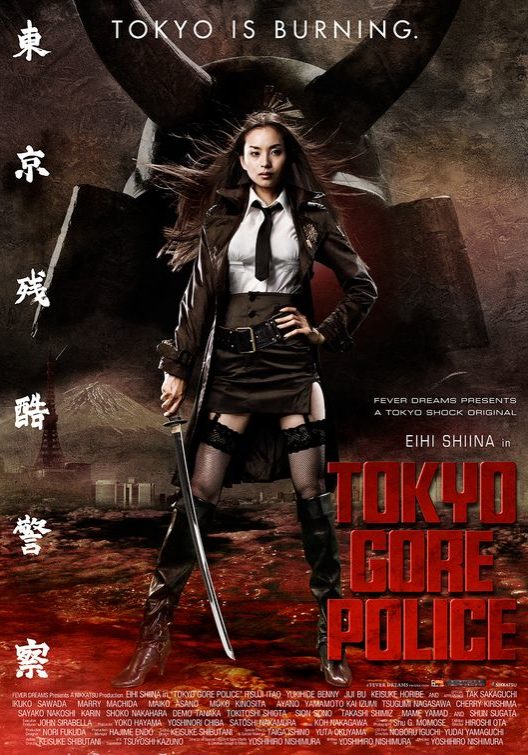A Bloody Canvas of Dystopian Chaos: “Tokyo Gore Police”
“The greater the pain, the greater the pleasure,” growls a voice from the twisted world of “Tokyo Gore Police.” Directed by Yoshihiro Nishimura and unleashed upon viewers in 2008, this film delves into a dystopian Tokyo overrun by genetically modified monsters known as ‘Engineers.’ We follow a dedicated police officer, Ruka, whose sole purpose is to exterminate these creatures. Her mission, however, becomes deeply personal as she uncovers truths about her past and the society she protects. “Tokyo Gore Police” is no conventional horror flick; it’s a visceral exploration of society’s underbelly, melding body horror with social satire.
The Sanguine Symphony
At its heart, the film is a masterstroke of mood—a diabolical blend of the grotesque and the satirical. Its atmosphere teeters on the brink of sensory overload, with manic energy and vibrant color palettes painting a Tokyo both futuristic and nightmarish. Yoshihiro Nishimura injects relentless shocks and spirals of violence that jolt viewers, but also provoke them to ponder the nature of pain and perversion. Cleverly, the film’s suspense doesn’t just lurk in the dark corners but dances brazenly in broad neon light.
The cinematography and visuals of “Tokyo Gore Police” are nothing short of an artful massacre. A whirlwind of blood and guts splatters across each frame with such creativity, one might forget to flinch. Sharp camera angles slash through scenes, while special effects tirelessly contort human flesh into monstrous forms. Uniquely, the film’s visual style doesn’t shy away from flaunting its lower budget, and instead, it embraces a grindhouse aesthetic that makes its gory tableau all the more engaging.
Sonic terror is expertly orchestrated here, with a soundtrack that punctuates the pandemonium and sound effects that slice into the psyche. The film understands the power of aural stimuli, utilizing everything from the slurping sounds of blood to the mechanical whir of bio-mutations to build its hellish soundscape.
Anatomic Actors and Altered Beasts
In a film where the characters occupy a world as unfathomable as this, the performances are pivotal in grounding the horror. Starring Eihi Shiina as Ruka, her portrayal of the stoic protagonist offers a mesmerizing calm in the storm of chaos. Her believability gives weight to a film that could easily become untethered from its narrative moorings. The supporting cast admirably keeps pace, contributing to the creation of a Tokyo populated by characters as twisted as the reality they inhabit.
Thematically, “Tokyo Gore Police” dissects and mutilates various horror subgenres, but its lifeblood is body horror. It revels in biological rebellion, showcasing mutations that test the viewer’s stomach—and their philosophy on the human form. Nishimura challenges the conventions of the genre by not just displaying gore, but by twisting it into satirical and political shapes that beg deeper contemplation.
The film employs an arsenal of fear tactics, from psychological unraveling to visceral gut-punches of gore. Rarely does it rely on jump scares, instead cultivating a disturbing ambience that claws into the viewer’s mind, insisting upon both revulsion and reflection.
Under the layers of blood, “Tokyo Gore Police” guts societal issues, from the privatization of police to the fetishization of violence. Its horror lens magnifies current anxieties, morphing them into monstrosities that are hard to watch, yet harder to ignore.
Fright’s Final Verdict
As a piece of horror cinema, “Tokyo Gore Police” is a chaotic symphony that is both harrowing and thought-provoking. It carves out its space within the genre, demanding attention not solely for its audacious gore but for its underlying subtext.
Those who revel in splatter-fests and subversive satire might find this film an intoxicating blend. It’s a wild ride, more suited for the hardened horror aficionado than the casual movie-goer. Newbies beware: this is a trek through terror that will test the limits of your comfort.
Comparatively, “Tokyo Gore Police” stands as an exile on the outskirts of mainstream horror, waving a bloody flag to fans of films like “Tetsuo: The Iron Man” and “The Machine Girl.” It’s a descendant of the extreme that knows its lineage and how to honor it—with more blood, more horror, and more unapologetic defiance.
In summary, while the film excels at gruesome visuals and has a strong lead, its narrative coherence occasionally suffers amidst the splattered chaos. Nonetheless, “Tokyo Gore Police” remains a visceral, memorable addition to the horror pantheon. Viewer discretion is heavily advised due to graphic content and potential triggers related to violence and body disfigurement. If you’re ready to plunge into the dark depths of Tokyo’s underbelly, this film is waiting to welcome you with blood-stained arms.




